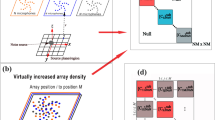Abstract
The quaternion multiple signal classification (Q-MUSIC) algorithm generally requires four-dimensional spectral peak search to estimate the direction of arrival (DOA) and polarization parameters, which would result in the huge computation burden. A dimension reduction Q-MUSIC algorithm (DRQ-MUSIC) based on L-shaped array is presented to reduce the computational complexity in this paper. The proposed algorithm divides the steering vector into three parts, and estimates each part separately, thus DOA and polarization parameters can be estimated only by N times one-dimensional spectral peak search, where N denotes the sources number. Besides, pair match is not required. Finally, simulation examples demonstrate the effectiveness and feasibility of the proposed algorithm.
Similar content being viewed by others
References
Wong K T, Zoltowski M D. Uni-vector-sensor ESPRIT for multisource azimuth, elevation, and polarization estimation [J]. IEEE Transactions on Signal Processing, 1997, 45(10): 1467–1474.
Wong K T, Yuan X. Vector cross-product direction-finding with an electromagnetic vector-sensor of six orthogonally oriented but spatiallt noncollocating dipoles/loops [J]. IEEE Transactions on Signal Processing, 2011, 59(1): 160–171.
Dayan R, Joseph T, Reuven S. Source localization using vector sensor array in a multipath environment [J]. IEEE Transactions on Signal Processing, 2004, 52(11): 3096–3103.
Yuan X, Wong K T, Xu Z X, et al. Various compositions to form a triad of collocated dipoles/loops, for direction finding and polarization extimation [J]. IEEE Transactions on Signal Processing, 2012, 12(6): 1763–1771.
Zhao J C, Tao H H, Gao Z Q. DOA estimation using dimension reduction quaternion estimation of signal parameters via rotational invariance techniques [J]. Chinese Journal of Radio Science, 2015, 30(3): 483–490.
Zheng G M, Wu B, Ma Y, et al. Direction of arrival estimation with a sparse uniform array of orthogonally oriented and spatially separated dipole-triads [J]. IET Radar, Sonar and Navigation, 2014, 8(8): 885–894.
Tao J W, Liu L, Lin Z Y. Joint DOA, range, and polarization estimation in the Fresnel region [J]. IEEE Transsactions on Aerospace and Electronic Systems, 2011, 47(4): 2657–2671.
Wang L M, Chen Z H, Wang G B, et al. Estimating DOA and polarization with spatially spread loop and dipole pair array [J]. Journal of Systems Engineering and Electronics, 2015, 26(1): 44–49.
Wu Y T, So H C, Hou C H, et al. Passive localization of near-field sources with a polarization sensitive array [J]. IEEE Transactions on Antennas and Propagation, 2007, 55(8): 2402–2408.
Nehorai A, Paldi E. Vector-sensor array processing for electromagnetic source localization [J]. IEEE Transactions on Signal Processing, 1994, 42(2): 376–398.
Hamilton W R. On Quaternions [M]. London: Proc Royal Irish Academy, 1843.
Miron S, Le B N, Mars J I. Quaternion-MUSIC for vector-sensor array processing [J]. IEEE Transactions on Signal Processing, 2006, 54(4): 1218–1229.
Le B, Miron S, Mars J I. MUSIC algorithm for vector-sensors array using biquaternions [J]. Transactions on Signal Processing, 2007, 55(9): 4523–4533.
Gong X F, Xu Y G, Liu Z W. Quad-quaternion low rank approximation with applications to vector-sensor array direction of arrival estimation [J]. Transactions of Beijing Institute of Technology, 2008, 28(11): 1013–1017.
Nie X, Li L P. A computationally efficient subspace algorithm for 2-D DOA estimation with L-shaped array [J]. IEEE Signal Processing Letters, 2014, 21(8): 971–974.
He J, Ahmad M O, Swamy M N S. Extended-aperture angle-range estimation of multiple Fresnel-region sources with a linear tripole array using cumulants [J]. Signal Processing, 2012, 92: 939–953.
Author information
Authors and Affiliations
Corresponding author
Additional information
Foundation item: Supported by the National Natural Science Foundation of China (60971108, 61101243)
Biography: ZHAO Jichao, male, Ph.D. candidate, research direction: vector sensor array signal processing.
Rights and permissions
About this article
Cite this article
Zhao, J., Tao, H. Estimation of DOA and polarization with COLD sensors based on quaternion model. Wuhan Univ. J. Nat. Sci. 22, 361–368 (2017). https://doi.org/10.1007/s11859-017-1259-9
Received:
Published:
Issue Date:
DOI: https://doi.org/10.1007/s11859-017-1259-9




